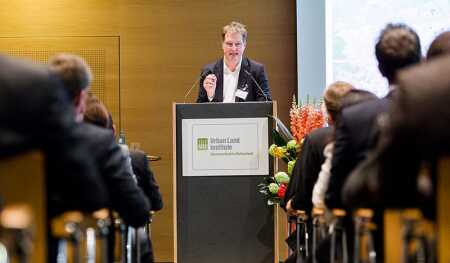Cologne, the fourth-largest city in Germany, is facing a population challenge. In recent years, the “little big city on the Rhine” has grown faster than projected, with a current population exceeding 1 million. One new projection from the city predicts that at least 142,000 new residents will move to Cologne by 2040—an increase of 13.5 percent. The majority of these newcomers are between the ages of 18 and 30; a quarter of new residents come from outside Germany.
But municipal leaders are embracing the challenge and working with residents to redesign and redevelop Cologne in a sustainable way to accommodate urban growth and preserve the city’s social diversity.
Franz-Josef Höing, councilor for city development, planning, and building in Cologne, spoke at a recent ULI Germany event in Frankfurt. Cologne has seen such waxing and waning many times throughout its history, and Höing highlighted several past master plans that changed the city during the 1900s, 1920s, and 1950s. “The cities get big and then they relax,” he said.
“Not so long ago, the urban exodus was considered irreversible by statisticians,” Höing said. “But this time is gone. Now, we worry the cities maybe aren’t big enough. A thousand families leave Cologne every year—not because they don’t like it, but because they can’t find the right space.”
Cologne remains one of the most affordable big cities in Germany. The average rents in Cologne for 2016 were €8.26 per square meter per month (equivalent to US$9.96 per square foot per year), an increase of less than 1 percent from 2015, putting it just outside the top ten most expensive cities in which to rent an apartment in Germany. The average sale price of a 75-square-meter (807 sq. ft.) condominium in Cologne for the final quarter of 2016 was €213,750 (US$233,340), landing around number 40 on the list.
Because there are not enough apartments on the market, real estate prices are rising, and “people who have kept real estate in cities for decades are now still waiting for the next price hike, hoping for even better times,” Höing said. “If we really think that cities should remain affordable, we have to detach ourselves from market mechanics.”
Right now, 15,000 apartments are being built throughout Cologne. But the city doesn’t only need more affordable housing, it also needs more daycare centers, schools, parks, and sport complexes. “It’s about the mix,” Höing said. There is, of course, a German word for this: Sozialenvielfältigkeit, or social diversity.
And it’s also about green spaces. “To preserve the green spaces in a city like Cologne, you can’t just build based on profits,” he said. “How do we want to live then? How do we get around? Public spaces that we all enjoy in cities must be planned—we can’t let it just be private development. Our predecessors in the 1920s created green spaces that we need to aspire to.”
Repurposing abandoned industrial and harbor areas will substantially change the right shore of the Rhein River in the coming years. New office buildings, apartment complexes, and parks will line the bank, just minutes away from the city center. This follows the example of Parkstadt Süd, a new neighborhood developed to preserve public green space.
The Cologne of the future needs to remain affordable for as many people as possible, with housing and public spaces that are well cared for and encourage integration and interaction among residents.
Talking about integration is one thing, but taking it to the streets is another. “Integration happens in public spaces and social housing,” Höing said. “When we visit, people don’t believe that the city is really interested. We have to convince them that we really want to know.”
Redesigning the city with developers is as much exciting as it is challenging. “The cities themselves have to write the stories,” Höing said. “The sails are full, and the people are interested in participating, so we planners are privileged to help the development.”





